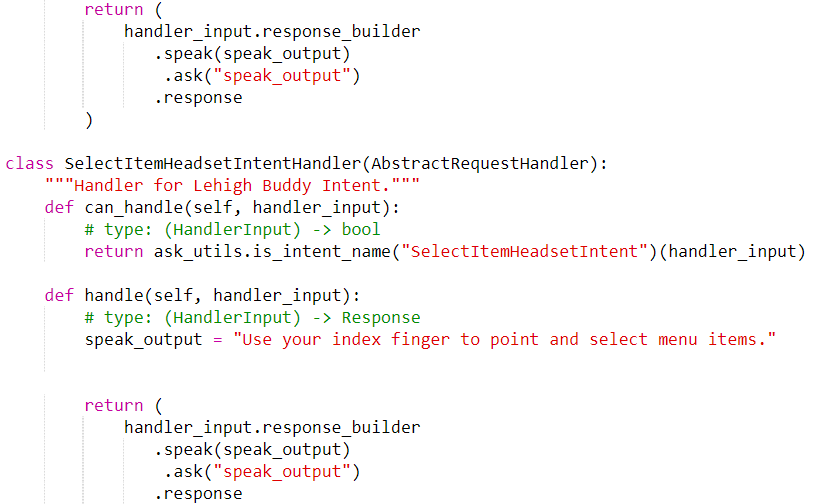ALEXA, an Interactive Artificial Intelligence (AI) System, works with Lehigh Buddy for the advanced development of next-gen virtual assistants that will assist humans in completing real-world problems through continuous learning and gaining the ability to perform human-like reasoning. Our goal is to accelerate several areas of AI through generalizable methodologies such as continuous learning, teachable AI, multimodal understanding, and reasoning.
What is ALEXA?
Alexa, Amazon’s cloud-based voice service, powers over 100 million devices from Amazon and third-party manufacturers. Designed to create natural voice interactions, Alexa makes technology more intuitive and accessible in everyday life. To support developers, Alexa offers a range of tools, APIs, reference solutions, and documentation to simplify the process of building apps (known as skills) for Alexa. Amazon's mission is to shape the future of artificial intelligence through Alexa working toward more seamless, intelligent, and personalized interactions that enhance everyday experiences.

How does ALEXA work?
Alexa operates through Amazon Web Services (AWS), which handles the voice processing in the cloud. When a user says the wake word ("Alexa"), the device captures the voice command and securely sends it to AWS for analysis. Using natural language processing and artificial intelligence, Alexa interprets the request and sends back a response in real time.
Developers can expand Alexa’s capabilities by creating Alexa Skills, which are custom voice applications. These skills are typically powered by AWS Lambda functions, often written in Python. This setup allows developers to program specific responses, actions, or information retrievals based on user input.
By combining voice recognition, cloud computing, and customizable backend logic, Alexa provides a dynamic and interactive experience that can be adapted to support a wide range of projects and user needs.
How is ALEXA being used?
In the NanoHuman Interfaces Intiative (NHI), Alexa is integrated into a wide range of projects, serving as a valuable tool for providing information and guiding users through various tasks. Its audio and visual versatility allows it to support numerous applications, making it a powerful resource for handling diverse projects.
Lightweight High Entropy Metallic Alloy Discovery (LHEAD)
One of the projects NHI has worked on is the ALEXA Blueprint meant for the user to ask about the materials being used for the project specifically regarding the Lightweight High Entropy Metallic Alloy Discovery, or LHEAD for short. LHEAD is working directly with NHI to improve structural materials such as superalloys to accelerate the innovation of high-performance materials. Users may ask ALEXA questions such as "What are superalloys?" or "How is NHI collaborating with LHEAD on this project?" ALEXA is used to inform the user about material sciences that are being used to advance the future of engineering and technology.
Lehigh Buddies and Headset Applications
NHI's individual Alexa apps are part of the customized information system known as Lehigh Buddies that help inform NHI Laboratory users how to operate advanced instrumentation throughout the lab. Lehigh Buddies works along side the NHI's customized mixed reality headset applications, such as the HoloMicroscope, to accelerate the pace of scientific research. Lehigh Buddies and headset applications are there to assist the user if they have any questions or need any assistance. The information system is able to memorize what it has done previously and will continuously learn from interactions with users. It will learn what users are interested, anticipate what is needed from the user and give a potential solution to the problem. In addition, it has the capacity to assist users by adapting its responses and continuously improving its ability to provide relevant and personalized support.
ALEXA Team

Dr. Andrea Harmer plays a key role in the Nano | Human Interfaces Alexa projects, initiating projects' directions and designing instruction to ensure all aspects of the Alexa AI technology align with the goal of accelerating scientific research. As the project's Advisor, she is responsible for both meeting objectives and maintaining the highest standards within the team.
Dr. Andrea Harmer retired as Chair of Library and Learning Technologies Department in the College of Education at Kutztown University in 2021, but continues to work part-time at Lehigh University on the Nano | Human Interface Presidential Research Initiative (NHI). Professor Harmer’s research interests include designing for learner engagement in middle and high school science and determining factors that promote young women’s awareness of and interest in pursuing STEM fields of study.
A variety of students have collaborated with Dr. Harmer to develop innovative projects using ALEXA. Below are a few students currently involved in these ongoing initiatives:

Aabiskar Thapa Kshetri is a third-year student at Lehigh University, College of Arts & Sciences. He is Mathematics and Computer Science double major student. He is working on this project as a programmer/Amazon Alexa Skill Developer. Aabiskar’s research interest lies on Natural Language Processing, Artificial Intelligence, Machine Learning and Human Computer Interaction.

As the Chief AI Officer at the Lehigh University Nano | Human Interface Presidential Initiative, Nix has contributed to the development of cutting-edge research in AI. Nix created a personalized virtual assistant on AWS Alexa, leveraging speech recognition and machine learning capabilities to improve user interaction. Nix also wrote and optimized scripts for simulations that model atomic resolution electron microscopy images, accelerating progress in materials research projects.

Diya is a junior majoring in Computer Science with a minor in Applied Mathematics. She has a strong interest in research, programming and Machine Learning applications to drive meaningful change.
